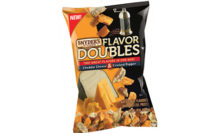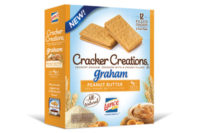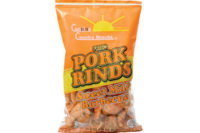Our 2013 State of the Industry report on snacks focuses on new snack products, the perspective of snack manufacturers and product leaders and market sales.
A proliferation of tasty new flavors, non-beef proteins and all-natural formulations demonstrate that jerky and meat snacks are doing swimmingly in the snack industry.
For most people, the word “jerky” conjures up images of the tough, dry, tasteless hunks of beef, devoured by grizzled cowboys in old Western movies. They could never imagine a group of young adults—men and women—eating jerky while on the go or after a game of water volleyball in the pool. But new meat snacks made from non-beef proteins, with healthier ingredients and in robust flavors are attracting people of all ages to this category.
“One of the main emerging trends in the meat snack category is alternate proteins (non-beef),” says Kevin Papacek, director of marketing, Jack Link’s Beef Jerky, Minong, Wis. “Jack Link’s has launched multiple alternate protein products and a turkey line including Turkey Jerky, Turkey Tender Bites, Turkey Strips, Turkey Sticks and a Turkey & Cheese Combo. [We] also recently launched BBQ Pork Jerky. [A] bright, vibrant, yet simple, packaging designs helps consumers easily recognize the new turkey and pork jerky products. The recently launched alternative protein products have resulted in early sales success.”
Brad Martin, director of convenience store sales for Bridgford Foods Corp., Chicago, also cites new types of protein as a category driver. “Pork, bacon and turkey seem to be surging right now,” he says. Two of the company’s newest product introductions are in line with this trend: Snack Bites made with 100% real pepperoni; and a tender Turkey Jerky.
For beef lovers, Bridgford recently launched Beef N Cheddar Beef Steak Tenders, Sweet N Spicy Sweet Baby Ray’s Beef Jerky and Kippered Beef Steak, the latter of which Martin says is for consumers who don’t necessarily want jerky.
Meanwhile, Monogram Food Solutions, Memphis, Tenn., is teaming with Garner, N.C.-based Butterball, LLC to launch the Butterball Turkey Meat Snacks line. Available at retail and convenience stores nationwide this summer will be Butterball Turkey Bacon Jerky, with smoky hickory notes; Butterball Teriyaki Turkey Jerky, with savory soy sauce; Butterball Oven Roasted Turkey Jerky; and Butterball Turkey Apple Nuggets, made with pieces of sweet, dried apples.
According to the company, the turkey snacks offer consumers better-for-you, lean protein products that are low in fat, calories and carbohydrates and have no added monosodium glutamate (MSG). Turkey Snack Bites and Giant Smoke Turkey Snack Sticks will round out the line.
In March, Monogram Food Solutions also added a Sweet Maple Glazed Bacon Jerky to its Johnsonville, Wild Bill’s, Bass Pro and Trail’s Best brands. The bite-sized, thick-sliced, hickory-smoked pieces are made from 100% real bacon that’s maple-cured and has a maple sugar glaze.
Some jerky manufacturers and consumers, meanwhile, are looking totally beyond traditional meats for their protein. “Several new product introductions have highlighted a previously untapped area of opportunity in the rapidly growing snack food space: Seafood snacks,” says Gabriel Viteri, vice president of strategy and business development at Acme Smoked Fish Corp. “Americans are snacking more than ever, and seafood snacks are finding a niche at the intersection of growing demand for health and variety.”
To that end, the Brooklyn, N.Y.-based company launched the Ruby Bay Salmon Jerky line in January 2012 with two flavors—teriyaki and peppered—available in a 1.25-oz. resealable bag. In April, an orange-ginger flavor joined the line, as did a 0.6-oz. strip for all three flavors.
Naturally better
Regardless of whether they’re buying beef, turkey, pork or salmon jerky, consumers are looking for brands made with all-natural or healthier ingredients.
“The biggest trend in the meat snack industry, as well as the food industry as a whole, has been the move toward more healthful, simple products without artificial preservatives or additives,” says Kap Pitarys, senior brand manager, Oberto Brands, Seattle. “Oberto has embraced this trend with the [Oh Boy! Oberto] All Natural Jerky line featuring simple recipes with all natural, wholesome ingredients and no artificial ingredients and preservatives.”
Response to the line, which launched in 2011, has been “overwhelmingly positive” from both consumers and retailers, Pitarys adds. In March, the company added All Natural Bacon Jerky. Made from lean, large strips of bacon, water, sea salt and sugar, it contains no added preservatives or artificial ingredients and has 20% less fat than pan-fried bacon.
“Consumers today are more health-conscious than ever, and protein is one of the hottest buzz words in food right now,” says Mike Kan, director of marketing of Golden Island Jerky. “Snacking is also a growing trend, due to changes in the modern working lifestyle, [which] explains why people are drawn to high-protein meat snacks.”
The Rancho Cucamonga, Calif., company makes all-natural beef and pork jerky in a variety of uncommon flavors. The beef jerky comes in Chili Lime, Mandarin Orange, Hickory Black Pepper, Five Spice, Kung Pao and Spice Curry, while the pork jerky is available in Teriyaki, Grilled Barbecue and Korean Barbecue.
Jason Havlick, president, Thanasi Foods, LLC, Boulder, Colo., says consumers are also more interested in the quality of the ingredients used in today’s jerky products, be they all-natural, gluten-free or some other formulation.
To that end, the company relaunched its Duke’s line in January as an all-natural brand. “We’ve taken out the MSG, erythorbate, colorings and things like that,” Havlick explains. “So, across the line, the brand now is truly natural, which we feel is a strong point of difference between the overall jerky category at convenience and retail across the country. Additionally, we have remained small-batch in terms of how we make our products. ”
The flavor factor
Duke’s Small Batch Smoked Meats also address another major trend in the jerky and meat snacks category: Consumer interest in hot and savory flavors. The line features 11 products—eight beef, one pork and two smoked sausage—with flavors like Chile ’N Lime, Cracked Pepper and Hot & Spicy. Several items feature co-branded flavors made with Jim Beam bourbon, Kikkoman Soy Sauce, STUBB’S Bar-B-Q Sauce and Frank’s RedHot Sauce.
Brian Levin, co-founder and “chairman of the herd” of Perky Jerky, Greenwood Village, Colo., cites Hot & Bothered as his favorite of the company’s three new, gluten-free flavor profiles. It, along with Teriyaki and Sweet & Spicy, are being used to season the company’s beef and turkey jerky.
“We’ve had our two basic SKUs—original beef and turkey—for a couple of years now,” says Levin. “In just two years, our turkey stock-keeping unit (SKU) has become the number-two turkey out there. Our product is a little bit different than most jerkys out there, being that it’s more tender, hand-crafted and all-natural.”
Perky Jerky’s new flavors are currently available in just 2.2-oz. bags; its Original Turkey and Original Beef Jerky come in 1-, 2.2- and 5-oz. bags.
“Consumers are constantly seeking new products with different flavors,” Papacek also says. “Jack Link’s has constantly been on the forefront of flavor innovation and continues to monitor consumer acceptance to unique new flavors through consumer research and product development. Jack Link’s plans to launch more new flavors of beef jerky in 2013 and 2014.”
In the meantime, consumers can excite their taste buds with Jack Link’s Beef Jerky flavors like Teriyaki, Peppered, Sweet & Hot, KC Masterpiece Barbecue, Jalapeno Carne Seca and Cholula Hot Sauce.
Getting into shape
Just like swimsuits come in different styles for different body shapes, jerky and meat snacks come in different shapes to accommodate consumer preferences and needs. A woman, for instance, might prefer neat-to-eat nuggets, while a man might want a bag of standard jerky strips. A teen, on the other hand, might favor an easy-to-carry stick.
Jack Link’s, for instance, recently launched the SQUATCH brand, a snack-stick line geared toward teens and young adults. The sticks come in two flavors (Original and Hot) and in packaging featuring eye-catching graphics and the brand’s memorable icon, Sasquatch.
The company’s new Big Dippers, jerky and dips packaged in a portable tray, also offer consumers convenient, on-the-go or by-the-pool snacking. Three combinations are available: All American (beef sticks and cheese sauce); Buffalo Chicken (buffalo chicken strips with ranch and buffalo sauce); and Barbecue (kippered beef steak strips and barbeque sauce).
Sheboygan, Wis.-based Old Wisconsin also introduced a line of Snack Stick products earlier this year. The line comprises a 1.5-oz. Original and Hot Habanero Snack Stick, a 2.5-oz. Original Twin Stick and a 1-oz. and 2.5-oz. Turkey & Cheddar Smoke Stack.
“We think we make the best meat snack stick out there,” says brand manager Jeff Weber. “We’ve taken it and combined it with shelf-stable Wisconsin cheese to make our Smoke Stack. We deliver it in a couple of different sizes. The size that seems to be doing real well is the 2.5-oz. package. You get a real, satiable treat for about $3.”
The company also added a 20-oz. Turkey Summer Sausage to its Old Wisconsin turkey meat snacks line, which features a 9-oz. Turkey Summer Sausage, 6-oz. Turkey Snack Slices, Turkey Bites in four package sizes and Turkey Snack Sticks in four sizes. “Those items are doing extremely well at retail supermarkets, but they’re still a work in progress on the convenience store side,” says Weber.
Jerky for everyone
So what type of consumers are buying products long equated with rugged, outdoorsy males?
“I believe women are becoming more and more apt to purchase meat snacks either for themselves or their significant other,” says Martin. One reason may be that these typically weight-conscious consumers are more likely to seek out snacks low in carbohydrates and fat and high in protein.
Weber concurs: “There’s no question that women are a larger part of the consumer base in retail supermarkets. I think women came into the category because there are no carbohydrates in these products. When we took our sticks and cut them into 1-in. pieces, we knew that we had dialed into women because no woman wants to rip a piece of meat with her teeth.”
Levin reports that Perky Jerky’s customer base is primarily women. “Women eat jerky, but they just tend to keep it in the closet, so to speak,” he says. “With our product, because it’s upscale and has great nutritionals in it, our fan base is really, really vocal about it.”
Duke’s primary consumer is male, but Havlick acknowledges that more women are the purchasers. “We’re still in that target audience of 21-40, with a median household income of below $80K, but we’re finding that more white-collar individuals in urban areas are consuming more jerky these days,” he says. “Quite frankly, I think beef jerky is becoming on-trend again. We think that the all-natural element and more exciting flavors will only help to encourage more trials by women and more health-minded consumers.”
Papacek describes Jack Link’s target consumer as “adventurous spirits”—men and women who work and play hard. “Even in their downtime, they crave an adventure that will turn the ordinary to something fun and entertaining,” he says. “They want food to be easy, great-tasting and satisfying.”
Similarly, Acme Smoked Fish Corp.’s target market is “adventure seekers and food enthusiasts looking for a healthy and nutritious protein snack,” says Viteri. “Seafood snacks are lightly gaining traction with on-the-go consumers.”
Because jerky is a high-impulse category, on-the-go consumers are Oh Boy! Oberto’s main target, says Pitarys. Golden Island Jerky and Monogram Food Solutions, on the other hand, are targeting consumers of all ages and cultures.
When it comes to target markets, Bridgford’s Martin sums it up best: “Each type of retailer ultimately has a different type of customer, and the objective is to be in the right place at the time of purchase in order to capture all consumer types.”
Challenges ahead
While jerky seems to be the popular kid at the pool party right now, the category faces some challenges.
“There are some other things going on with jerky that are not tremendously good for the category,” says Weber. “One is pricing for anything that’s beef-related. We’re at all-time highs now, and we’re headed for even higher prices. There’s been a little push back by consumers unwilling to pay $6-$7 for a handful of jerky.”
The rising cost of livestock feed, capital investments associated with livestock and fuel costs are also impacting the category.
“The biggest challenge probably still is the price point, which is driven by the fact that when you cook 1 lb. of beef—when you dehydrated that down—you’re left with 5-6 oz. of product,” says Havlick. “It’s challenging as a commodity, but also challenging from a standpoint of production cost. We’re seeing the average price point of our product out there at $6.49, a fairly significant expense for someone who walks into a convenience store, where the bulk of jerky is sold.” He adds that Thanasi Foods has absorbed its meat cost increases and not raised its Duke’s jerky prices.
And while beef jerky manufacturers are feeling the impact of rising protein prices, salmon jerky producers are, too. “For salmon jerky, the biggest challenge is competing with beef jerky on price,” says Viteri. “Wild salmon is simply less available than beef [and], hence, more expensive.”
Another challenge today’s jerky manufacturers must deal with is an “overabundance of players,” says Martin. “Manufacturers are now forced to provide a unique flavor or product that will cause the consumer to stop, look and ultimately buy. The product then needs to stand on its own, so it will be bought again and again.”
Perky Jerky’s Levin describes competition within the jerky industry as a “Jean-Claude Van Damme blood sport. When you have a category that can be sold in so many places—grocery, club, specialty, military, convenience—there’s obviously a lot of competition.”
Papacek offers up a few additional challenges: Consumer perceptions; merchandising; and overall awareness and importance of the category in the overall salty snacks. “First, some consumers perceive meat snacks as unhealthy,” he explains. “However, jerky products are a healthy snack alternative compared to other snack options. Second, obtaining the proper placement and display for the category continues to be a challenge. The placement and amount of space dedicated to the category can vary widely by channel and retailer. Finally, meat snacks make up a very important category in the world of salty snacks. It is the third largest category behind potato chips and tortilla chips, which should make more consumers and customers think how the category can help them make better snacking choices and grow sales.”
Open to opportunities
But there are plenty of opportunities for jerky and snack meat producers as well.
The proliferation of specialty and artisanal varieties continue to propel jerky from a gas-station snack to a gourmet snack sold in specialty stores, says Viteri. This translates into even more sales outlets for jerky and meat snacks.
Martin notes that continued retail growth and smaller pack sizes are opening a niche for larger bags in the $10-plus retail category. “People who want to buy those bags don’t seem to be affected by the higher ring, and are looking for the larger pack with a quality product inside,” he explains.
For Kan, innovation represents the greatest opportunities for growth in the jerky category. “Jerky isn’t a new product,” he says. “It’s been around for hundreds of years, and pretty much everyone knows what jerky tastes like. Most people already know if they like it or hate it. However, with the recent rise in demand in high-protein snacks, many consumers who didn’t eat jerky before are looking at this product in a new way. At Golden Island, we recognize this as an opportunity to reinvent the perception people have about jerky.”
Pitarys concurs: “One of the greatest opportunities for growth in the meat snacks category is to provide meaningful innovation to jerky consumers and entice new consumers to buy within the category. Brands need to stay current and relevant to their consumers.”
And given all the new proteins, flavors and shapes jerky manufacturers are placing before consumers, it’s unlikely they’ll be heading to the pool empty-handed.

















